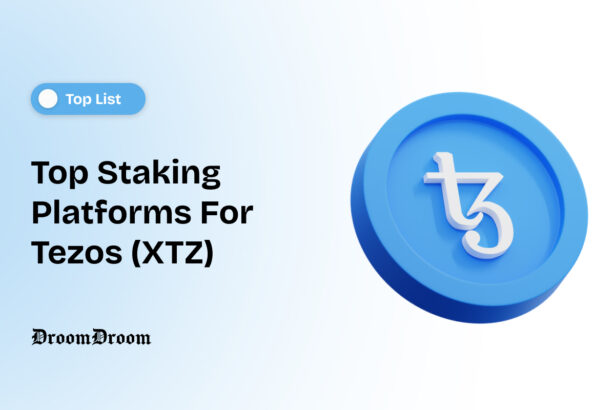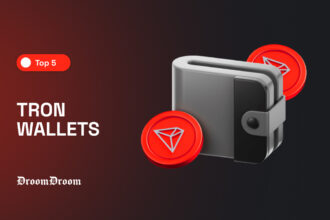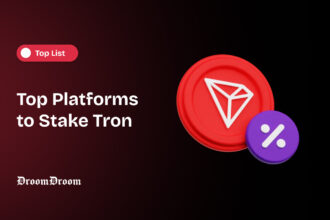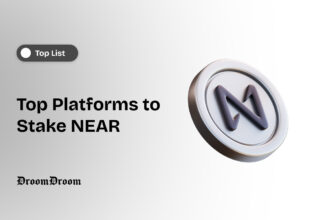Tezos(XTZ) Staking has become a popular way for cryptocurrency holders to earn passive income. This is through supporting the Tezos blockchain’s security and consensus mechanism.
Staking cryptocurrencies has become increasingly a common method to generate passive income. When you stake your crypto, it means you receive rewards for participating in the validation of blockchain transactions. Some of the best staking places include Binance, CoinBase, and Atomic Wallet among others.
As the blockchain industry continues to grow, numerous platforms have emerged and are offering staking services for Tezos. One remarkable aspect of staking is that it provides higher returns compared to traditional savings accounts.
What is Staking?
Staking is a process used in blockchain networks to support the network’s operations. It helps in achieving consensus, and securing the network while earning rewards. It also involves participants referred to as ( “validators”).
They lock up a certain amount of their cryptocurrency tokens as collateral, to enable them to be eligible to validate transactions and create new blocks on the blockchain.
In the process of staking, a certain number of tokens is allocated to the governance model of the blockchain, thereby locking them out of circulation for a specified period of time.
The tokens are usually used to govern the blockchain if the network uses a proof-of-stake (PoS) system.
A PoS system ensures that coins are staked to produce new blocks in the blockchain, for which participants are rewarded.
In this comprehensive guide, we will explore the ten best places to stake Tezos(XTZ) . We will base it on factors like reputation, rewards, user experience, security, and community feedback.
More to read : Comprehensive Guide on Cryptocurrency Exchange Aggregators
Top Platforms for Tezos Staking
Tezos, an open-source blockchain, facilitates peer-to-peer transactions. It serves as a versatile platform for deploying smart contracts, engaging in decentralized finance(DeFi), decentralized applications(dApps), and non-fungible token(NFT) projects.
The native cryptocurrency, called “tez” plays a pivotal role in the network’s ecosystem. Through staking your Tezos(XTZ), one can actively contribute to network security thus enabling them to earn their rewards peacefully. There are several platforms for staking Tezos. Let’s know each of them one by one in brief:
Kraken
Kraken is a well-known American crypto exchange and was founded in 2011. It’s used worldwide mainly for buying, selling, and trading a variety of different cryptocurrencies. Kraken also offers users the ability to stake several coins, Tezos included.
Kraken is known for its powerful security measures and regulatory compliance. It is a reliable exchange that focuses on customer safety. It provides a fantastic benefit where there are no lock-up staking features, this allows one to stake their funds without them being frozen during the staking period.
For those crypto investors looking for a secure staking option, Kraken is an acceptable choice for many. In addition, its user-friendly interface makes it also accessible to users of all levels. The current price of one Tezos token is approximately five dollars. This makes it an affordable option and also it doesn’t strain someone’s finances if they decide to acquire a few tokens.
Binance
Binance, is one of the biggest and most recognized cryptocurrency exchanges. It offers great features such as crypto margin trading, lending service, and staking crypto. The Binance program also allows one to stake other 25 different tokens including Tezos.
One good thing about staking Tezos with Binance, is that there are no fees needed for staking it. It only requires you to buy at least 1 XTZ in order to start staking.
To maximize rewards, all earned profits are shared with Binance users. One great benefit of Binance is that you can stake Tezos while waiting for a trade.
Binance offers a secure and reliable platform for trading and staking. Binance users can stake XTZ directly from their exchange wallet and enjoy competitive rewards.
There is no fixed plan, you can sell some of your Tezos tokens while you are still staking.
On October20.2020, Binance introduced XTZ staking alongside ATOM and TRX, which offered a promotional annual percentage yield(APY) of 20.58%. During this time, the staked tokens are subject to a lock-up period until they reach maturity, at which point they become withdrawable. The maturity period varies based on the specific staking product you purchased.
More to read : Binance – Making Crypto Trading Efficient
Coinbase
Tezos was launched on Coinbase on the 6th of November, 2019 with an APY offering of 5% at the time. It is a user-friendly platform that caters to beginners, making it an excellent option for those new to staking.
It enables eligible users to easily stake their Tezos directly from their Coinbase wallet. Coinbase also provides a transparent and straightforward staking process.
Currently, Coinbase offers a reward rate of 4.63% for staking Tezos, and one only needs a dollar worth of XTZ to get started.
However, there is a glaring downside to staking on Coinbase. Coinbase charges a 25% fee for all its staked coins, which is taken from your rewards.
This is considerably higher than the fees of other exchanges and wallets, considering that many platforms don’t even charge a staking fee.
Exodus Wallet
Exodus Wallet is a popular multi-cryptocurrency wallet that enables users to stake Tezos directly from the wallet interface. Its user-friendly design and secure environment make it an attractive option for Tezos holders.
Exodus offers a reward rate of around 6% for staking your Tezos, and one only needs 1 XTZ to get started.
This implies that, once you begin staking, you will need to wait for around 5 weeks to start earning rewards. But after the waiting period is over, you start earning your rewards every three weeks.
Exodus Wallet also offers both a desktop and smartphone app, both of which are free to download.
If you want to stake Tezos using Exodus, it’s straightforward and quick regardless of which device you’re using.
Ledger Wallet
Ledger stands apart from traditional crypto exchanges and software wallets as it offers a hardware wallet solution. With Ledger hardware wallets, one can securely store the essential public and private keys required to access cryptocurrency funds.
For Tezos staking via Ledger, one needs to invest in their hardware wallet and install Ledger Live, which is a user-friendly application available for free on desktop and smartphone devices.
Moreover, Ledger Live boasts reliable customer support to assist you promptly in case you encounter any challenges while using the software.
Also, When you store XTZ coins on a Ledger wallet, you can stake them using the Ledger Live application. In return, you will receive an APY of approximately 6%, minus minimal fees.
Atomic Wallet
Atomic Wallet is a decentralized wallet available for both desktop and mobile devices. It supports over 500 different coins and is suited to investors of all levels. The wallet provides a simple and convenient way to store and stake crypto.
Diverging from traditional exchanges like Kraken or Binance, Atomic Wallet distinguishes itself as a software wallet.
It is designed to cater to your cryptocurrency staking needs, including Tezos(XTZ). Staking on Atomic Wallets proves to be remarkably convenient.
This is because staking is highly inclusive, with only 1 XTZ required as the minimum staking amount, this makes it accessible to almost every user.
In terms of reward, Atomic Wallet offers an attractive rate ranging between six and seven percent.
However, it’s essential to acknowledge that your funds will be locked up for the duration of the staking period.
Nevertheless, a notable perk of staking with Atomic Wallet is the absence of any staking fees, providing an extra benefit to the already compelling offer.
Guarda Wallet
Staking Tezos(XTZ) on Guarda Wallet offers a seamless and secure way to participate in the Tezos network. It also help one earn passive income through staking rewards. As a non-custodial wallet, Guarda ensures that you retain full control of your private keys and funds, this provides an extra layer of security throughout the staging process.
For one to start staking on Guarda Wallet, there are steps to follow:
a. Installing Guarda Wallet
b.Importing Wallet: If you’re new to Guarda, you can create a new wallet within the app
c.Add Tezos(XTZ) to your Wallet: Once your wallet is set up, you can add Tezos to it by receiving XTZ from an exchange or another wallet.
d.Navigate to Staking
e.Choose a Validator: Guarda allows you to select a validator to delegate your XTZ. One can research different validators to find one with a reliable track record and attractive staking rewards.
f.Delegate your XTZ: This process does not require sending your XTZ anywhere, it only involves delegating your staking rights. When one stakes their XTZ, this means they will begin receiving staking rewards, these rewards are automatically added to their wallets. The rewards are also frequently distributed at regular intervals, this depends on the Tezos network’s staking rules.
CoinDCX
When one stakes their Tezos on CoinDCX, they are given an opportunity to earn yielding income .That is through participating in the network’s proof-of-stake(PoS) consensus mechanism. On CoinDCX, users have the opportunity to earn a 3% Annual Percentage Rate(APR) on their Tezos deposits by making them available to potential borrowers. To be eligible for this offer, users must register on CoinDCX and complete the Know Your Customer(KYC) requirements.
The minimum duration for generating passive returns is 7 days. While users can withdraw their assets at any time, withdrawing before the minimum tenure might result in the forfeiture of any earned rewards. This means your staked XTZ will be unavailable for withdrawal until the staking period ends.
Kucoin
On September 21, 2019, Kucoin introduced Tezos(XTZ)for staking, offering an Annual Percentage Yield(APY) to its users. The staking service, also known as soft stalking or flexible staking, allows users to earn a 2% APY when staking XTZ with the exchange.
It is important to know that KuCoin adjusts its staking proportion daily based on the total value of tokens and the withdrawal records in its platform wallet.
KuCoin stands out by providing high yields on various low-cost crypto assets available in the market, making it a unique offering.
However, for the Tezos token, the platform has chosen to offer only a soft staking program, which limits users’ options to this particular product.
OKEX
On November 7, 2019, OKEx introduced Tezos for staking on its platform. In order to participate in Tezo’s stake on OKEx, There is a minimum amount of XTZ that users are required to stake.
The minimum amount is 50 XTZ, and users are also allowed to redeem their staked assets within 24 hours. OKEx streamlines the process of buying cryptocurrencies and staking them, making it a user-friendly experience for investors.
One of the famous aspects of staking Tezos on OKEx is the platform’s influence as a trusted exchange. It is also known for its security measures and regulatory compliance. OKEx provides its users with a user-friendly connection and a reliable platform to help them manage their staking activities.
Conclusion
Staking Tezos (XTZ) has become a profitable option for cryptocurrency holders. This has helped them to earn passive income while supporting the Tezos blockchain. The marketability of staking Tezos has been seen increasing and various platforms have emerged, each offering its unique features and rewards.
Remember, it is important to conduct thorough research and consider factors like reputation, rewards, user experience, security, and community feedback before deciding on a staking platform.
Also don’t forget that staking involves risks, which include potential lock-up periods and the possibility of market fluctuations. Therefore, it is essential to understand the staking terms and risks associated with each platform. Always store your Tezos securely and consider diversifying your investment to reduce potential risks.



















